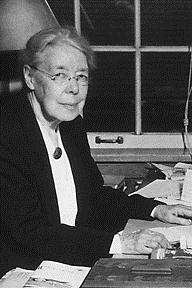Elizabeth Laird (physicist)
Elizabeth Rebecca Laird (December 6, 1874 – March 3, 1969) was a Canadian physicist who chaired the physics department at Mount Holyoke College for nearly four decades. She was the first woman accepted by Sir J. J. Thomson to conduct research at Cambridge University's Cavendish Laboratory. Laird graduated from the London Collegiate Institute in 1893, and attended University College of the University of Toronto after, due to her gender, she was denied an exhibition scholarship where she could have studied abroad.[1] She earned her Ph.D. in physics and mathematics from Bryn Mawr College in 1901.
Elizabeth Laird | |
|---|---|
 | |
| Born | December 6, 1874 |
| Died | March 3, 1969 (aged 94) |
| Nationality | Canadian |
| Alma mater | University of Toronto, Bryn Mawr College |
| Scientific career | |
| Fields | Physics |
| Institutions | Mount Holyoke College, Cavendish Laboratory |
| Thesis | The absorption spectrum of chlorine (1901) |
| Doctoral advisor | A. S. MacKenzie |
Asteroid (16192) Laird is named in her honour.
Biography
Early life and education
Elizabeth Laird was born on December 6, 1874, in Owen Sound, Ontario. Her mother was Rebecca Laird and her father was Reverend John Laird, a Methodist minister.[1]
In 1893 Laird graduated from the London Collegiate Institute, and went on to earn her bachelor of arts degree in mathematics and physics from University College of the University of Toronto in 1896, where she received the University's Gold Medal.[1] She taught for a year at Ontario Ladies' College.[2] In 1898 she received a postgraduate fellowship in physics from Bryn Mawr College. She studied at the Humboldt University of Berlin from 1898 to 1899, working with Max Planck and under Emil Warburg on time lag in magnetization.[2][3] During her time there, she became the first person to use a Nernst lamp for a physics project.[4] Laird earned her Ph.D. in physics and mathematics from Bryn Mawr College in 1901 for her spectroscopy and magnetism work.[2] She received honorary degrees from the University of Toronto in 1927 and the University of Western Ontario in 1945.[4]
Career
Mount Holyoke College
Laird was hired by Mount Holyoke College as an assistant in physics in 1901. She was promoted to instructor the following year and appointed head of the Physics Department in 1903. She was the first woman accepted by Sir J. J. Thomson to conduct research at Cambridge University's Cavendish Laboratory.[1] She retired to emerita status in 1940.[4]
Later career
Laird came out of retirement during World War II to research radar at University of Western Ontario for the Canadian National Research Council.[4] Her retirement home was in London, Ontario and she turned up at the research centre in 1940, asking to help. She worked there without pay but took a full part in the research, including the experiments in the unheated antenna building. In 1945, she was made an honorary professor of physics there and continued working upon the absorption of ultra-high frequency radiation by tissue until her second retirement in 1953.[1][2] Physicist A.D. Misener said that Laird was "the rare combination of a conscientious and productive research worker and an inspiring and able teacher."[4]
Laird died on March 3, 1969 in London.[2]
References
- Oakes, Elizabeth (2007). Encyclopedia of World Scientists. Infobase Publishing. p. 423. ISBN 0-8160-6158-0.
- Zimmer, Mitchell. "Dr. Elizabeth Rebecca Laird". Western Science. Archived from the original on 2013-10-20. Retrieved 19 Oct 2013.
- Ogilvie, Marilyn; Harvey, Joy, eds. (2000). "Laird, Elizabeth Rebecca (1874–1969)". The Biographical Dictionary of Women in Science: L-Z. Taylor & Francis. pp. 734–735. ISBN 978-0-415-92040-7.
- "Elizabeth Rebecca Laird". Contributions of 20th Century Women to Physics. UCLA. Archived from the original on 22 October 2013. Retrieved 21 October 2013.